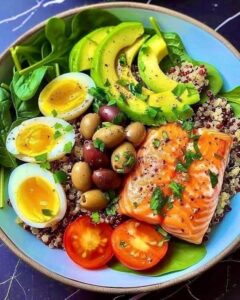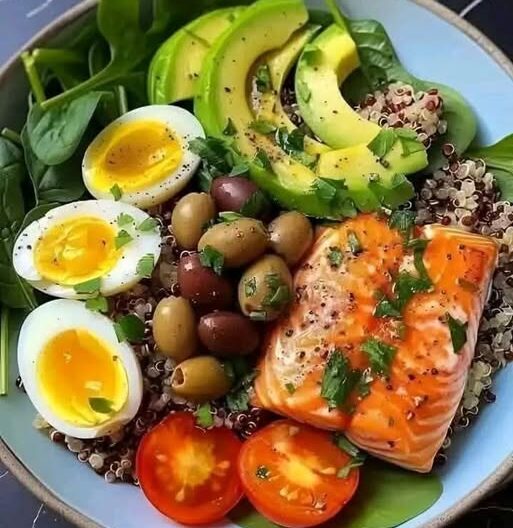There’s something incredibly satisfying about a meal that not only tastes amazing but also makes you feel good from the inside out. For me, that’s exactly what the Salmon Power Bowl represents. I still remember the first time I made one—it was during a particularly busy week when I needed something quick, healthy, and filling. As I layered fresh greens, perfectly cooked salmon, vibrant veggies, and a tangy dressing, I realized I had stumbled upon something special. It wasn’t just food; it was fuel for my body and soul. Whether you’re looking to upgrade your lunch routine, meal prep for the week, or simply enjoy a nutrient-packed dinner, this bowl has everything you need. Let’s dive into how you can create this flavorful dish and make it a staple in your kitchen.
What Makes the Salmon Power Bowl So Special?
A Perfect Balance of Nutrition and Flavor
Few dishes manage to combine health and taste as seamlessly as the Salmon Power Bowl . At its core, this dish is a celebration of wholesome ingredients working together in harmony. The star of the show—salmon—is rich in omega-3 fatty acids, which are essential for heart health, brain function, and reducing inflammation. Pair that with fiber-packed grains, antioxidant-rich vegetables, and a zesty dressing, and you’ve got a meal that’s as nourishing as it is delicious.
The beauty of this bowl lies in its versatility. You can tailor it to your taste buds or dietary needs while still reaping its nutritional benefits. Whether you prefer quinoa, brown rice, or a bed of mixed greens, the foundation supports endless creativity. And let’s not forget the dressing—it ties everything together, adding a burst of tanginess or creaminess that elevates the entire experience.
 Why This Recipe Stands Out
Why This Recipe Stands Out
What sets the Salmon Power Bowl apart is its ability to cater to diverse lifestyles and preferences. Need a quick lunch option? This bowl can be prepped in under 30 minutes. Want something hearty yet light? The combination of protein, healthy fats, and fiber keeps you full without weighing you down. Plus, it’s perfect for meal prep—you can assemble multiple bowls at once and store them for the week ahead.
Another standout feature is its adaptability. Whether you’re vegan, gluten-free, or simply craving something different, this recipe can be customized to suit your needs. Swap salmon for tofu, use cauliflower rice instead of grains, or add superfoods like avocado or hemp seeds—the possibilities are endless.
Ingredients You’ll Need for the Perfect Salmon Power Bowl
Before you get started, let’s talk ingredients. Choosing high-quality components ensures your bowl is as flavorful and nutritious as possible. Here’s what you’ll need:
Table Breakdown of Ingredients
Tips for Ingredient Selection
- Salmon: Opt for wild-caught salmon over farmed varieties for higher omega-3 content and better flavor. If fresh salmon isn’t available, canned salmon works too—just drain and flake it before using.
- Grains: Choose whole grains like quinoa or brown rice for sustained energy. For a low-carb option, use cauliflower rice or skip the grain entirely and serve over mixed greens.
- Veggies: Use seasonal produce to ensure freshness and affordability. Roasted vegetables like sweet potatoes or broccoli can also add depth and warmth to the bowl.
- Dressing: Fresh lemon juice and high-quality olive oil make a world of difference. Avoid bottled dressings, as they often contain added sugars and preservatives.
By selecting the right ingredients, you’ll create a bowl that’s not only nutritious but also bursting with flavor.
Step-by-Step Guide to Making the Salmon Power Bowl
Now comes the fun part—putting it all together. Don’t worry; even if you’re new to cooking, this process is easy to follow. Let’s break it down step by step.
Preparing the Salmon
- Season the Salmon: Pat the salmon dry with paper towels and season generously with salt, pepper, and a drizzle of olive oil. This simple seasoning allows the natural flavors of the fish to shine.
- Cook the Salmon: Heat a skillet over medium-high heat and add a splash of olive oil. Place the salmon skin-side up and cook for 4–5 minutes per side until golden and flaky. Alternatively, bake it at 400°F (200°C) for 12–15 minutes for a hands-off approach.
Assembling the Base
- Prepare the Grains: Cook quinoa or brown rice according to package instructions. For a no-cook option, use pre-washed mixed greens.
- Divide the Base: Spoon the grains or greens evenly into bowls, creating a sturdy foundation for the other ingredients.
Adding the Veggies
- Chop and Slice: Halve the cherry tomatoes, dice the cucumber, slice the avocado, and shred the carrots. These colorful additions not only look beautiful but also provide a variety of textures and nutrients.
- Layer the Veggies: Arrange the vegetables artfully over the base. This step is where you can get creative—think about balancing colors and flavors.
Finishing Touches
- Flake the Salmon: Once the salmon is cooked, gently flake it into bite-sized pieces using a fork. Place it on top of the veggies for a protein-packed centerpiece.
- Add Toppings: Sprinkle sesame seeds, chopped nuts, or crumbled feta cheese for added crunch and flavor.
- Drizzle the Dressing: In a small bowl, whisk together olive oil, lemon juice, honey, and Dijon mustard. Drizzle the dressing over the bowl just before serving to keep the ingredients fresh.
Pages: 1 2

